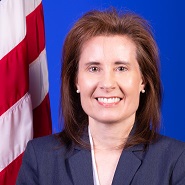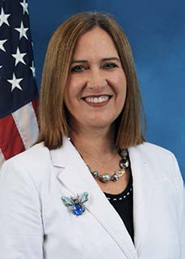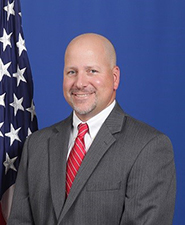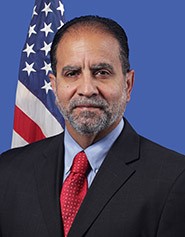Lisa A. Ryan
 Lisa A. Ryan serves as the Deputy Regional Administrator, Southwest Region. She directly supports the Regional Administrator, Southwest Region as the second principal FAA representative and provides leadership and agency representation with state and local governments, aviation organizations, educational institutions, aviation industry representatives, civic and local organizations, and other Federal agencies.
Lisa A. Ryan serves as the Deputy Regional Administrator, Southwest Region. She directly supports the Regional Administrator, Southwest Region as the second principal FAA representative and provides leadership and agency representation with state and local governments, aviation organizations, educational institutions, aviation industry representatives, civic and local organizations, and other Federal agencies.
Ms. Ryan also serves as the Department of Transportation (DOT) Regional Emergency Transportation Coordinator (RETCO) for the DOT region within her purview. She leads coordinated DOT emergency transportation programs tailored to the requirements of the Southwest region and directs the development of contingency planning, along with the necessary training and exercises, to confirm preparedness for emergency response within the region. Contingency planning efforts are coordinated with other DOT Operating Administrations, the Federal Emergency Management Agency (FEMA) and other Federal, state, and local organizations.
Ms. Ryan has over 16 years of FAA experience. She began her Federal career in Finance where she built financial pay and staffing models to support her engagement in multiple union negotiations as well as the air traffic controller workforce planning efforts. She went on to hold leadership positions within the FAA's Air Traffic Organization to include: Technical Operations, Safety and Technical Training, Program Management Organization and System Operations.
Prior to assuming her role as the Deputy Regional Administrator, Southwest Region she served as the Director of Operational Readiness, System Operations Services. While in this position Ms. Ryan lead the agency and industry into a new perspective of Operational Contingency Planning to include activities such as: rebuilding air traffic facility operational contingency plans (OCP) for all facility domains (ATCTs, TRACONs, ARTCCs, & Oceanic), developing and deploying facility exercises to confirm OCP awareness, building Letters of Agreement (LOA) with International Air Navigation Service Providers, building LOAs with airports, rewriting and sustaining the Agency Contingency Order, and leading a collaborative contingency workgroup with an array of industry stakeholders.
Ms. Ryan holds a Bachelor of Science degree in Engineering & Management from Clarkson University and a Master of Science degree in Education from Canisius College.


 Abby Smith, as the Executive Director of Policy and Plans within the Office of Policy, International Affairs, and Environment; oversees strategic planning and policy development for the Federal Aviation Administration (FAA). She also provides formulation of aviation policies, plans, goals, and priorities through stakeholder outreach.
Abby Smith, as the Executive Director of Policy and Plans within the Office of Policy, International Affairs, and Environment; oversees strategic planning and policy development for the Federal Aviation Administration (FAA). She also provides formulation of aviation policies, plans, goals, and priorities through stakeholder outreach. Mr. David S. Burkholder serves as the Acting Executive Director for the Office of International Affairs in the U.S. Federal Aviation Administration (FAA). In this role, he is the principal advisor to FAA leadership on matters of international policy, global affairs, foreign training and technical assistance, and strategic international engagement and related prioritization of resources in support of FAA global priorities and initiatives. He coordinates FAA efforts to advance U.S. aviation policies, positions, technologies, and procedures internationally with international organizations, domestic and international industry stakeholders, U.S. Government Agencies, Civil Aviation Authorities (CAA) and Air Navigation Service Providers (ANSPs). Mr. Burkholder is also accountable to encourage the advancement of aviation safety oversight and standardization of global policies, practices and procedures across all regions. Previously, he served as the Deputy Executive Director in the Office of International Affairs.
Mr. David S. Burkholder serves as the Acting Executive Director for the Office of International Affairs in the U.S. Federal Aviation Administration (FAA). In this role, he is the principal advisor to FAA leadership on matters of international policy, global affairs, foreign training and technical assistance, and strategic international engagement and related prioritization of resources in support of FAA global priorities and initiatives. He coordinates FAA efforts to advance U.S. aviation policies, positions, technologies, and procedures internationally with international organizations, domestic and international industry stakeholders, U.S. Government Agencies, Civil Aviation Authorities (CAA) and Air Navigation Service Providers (ANSPs). Mr. Burkholder is also accountable to encourage the advancement of aviation safety oversight and standardization of global policies, practices and procedures across all regions. Previously, he served as the Deputy Executive Director in the Office of International Affairs.  Nicholas Reyes is the Director, Western Hemisphere, Office of International Affairs (API) with base in Panama City, Panama. As the Director, Western Hemisphere Office, he is responsible for promoting U.S. interests and advancing civil aviation safety, security and efficiency. He plays a lead role in the development of international aviation policy and serves as the chief advocate for the U.S. aviation interests in the region. Mr. Reyes works directly with top U.S. and foreign civil aviation officials and serves as the agency's chief spokesperson at major international aviation forums to articulate and advance FAA policy.
Nicholas Reyes is the Director, Western Hemisphere, Office of International Affairs (API) with base in Panama City, Panama. As the Director, Western Hemisphere Office, he is responsible for promoting U.S. interests and advancing civil aviation safety, security and efficiency. He plays a lead role in the development of international aviation policy and serves as the chief advocate for the U.S. aviation interests in the region. Mr. Reyes works directly with top U.S. and foreign civil aviation officials and serves as the agency's chief spokesperson at major international aviation forums to articulate and advance FAA policy.